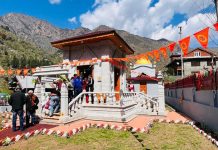
The central rule was imposed for the first time on March 26, 1977 after the Congress withdrew support to Sheikh Mohammad Abdullah-led NC government. Since then, successive state governors have helmed the affairs of the state on number of occasions, writes Riaz Wani
It was on June 19, 2018, that the BJP withdrew support to the J&K coalition government headed by the then Chief Minister Mehbooba Mufti, paving the way for Governor’s rule in the then state. Later, former J&K Governor, Satya Pal Malik, dissolved the assembly in November. Over five years have passed since then, and there are no signs of the long-awaited assembly elections.
Following the abrogation of Jammu and Kashmir’s special status on August 5, 2019, the region was downgraded to a union territory. The position of the Governor was reduced to that of Lieutenant Governor.
Governors have been direct participants in the history of the state, helping shape and direct it during their respective periods of rule.
Governor’s rule was imposed for the first time on March 26, 1977 during the tenure of Governor L K Jha after state Congress – then headed by Mufti Mohammad Sayeed – withdrew support to the minority government of Sheikh Mohammad Abdullah of National Conference. Sheikh had come to the power following an accord with the then prime minister Indira Gandhi in 1975, which ended his 23 years of struggle for self-determination.
The Governor’s rule lasted for 105 days and ended as Abdullah returned to power in the Assembly polls.
Governor’s rule was imposed for the second time in March 1986 after the state Congress — again headed by Sayeed — withdrew support to the minority Government of Ghulam Mohammad Shah.
Shah became the Chief Minister after he led a rebellion against his brother-in-law and then incumbent Chief Minister Farooq Abdullah in 1984.
This 246-day spell ended after Farooq Abdullah entered into an alliance with the then prime minister Rajiv Gandhi called Rajiv-Farooq accord.
The third time Governor’s rule was imposed in January 1990 when Farooq Abdullah resigned as the chief minister over the appointment of Jagmohan as the Governor following eruption of militancy in the state.
Mufti Sayeed was the Union Home Minister at that time and had brushed aside Farooq Abdullah’s opposition to Jagmohan’s appointment. This was the year when the armed separatist uprising began in Kashmir and Jagmohan was sent back to the state with a hope that he will replicate the success of his previous tenure. His short spell at the helm was marked by a tough security response to the then rampant militancy.
Jagmohan was followed by Girish Chandra Saxena and K V Krishna Rao. Between them they presided over the longest Governor rule – six years and 264 days — which ended in October 1996 after the National Conference returned to power in Assembly elections held after a gap of nine-and-a-half years.
In October 1996, the National Conference returned to power in Assembly elections held after a gap of nine-and-a-half years.
Six years later, Governor’s rule had to be imposed in the state for the fourth time in October 2002 after caretaker Chief Minister Farooq Abdullah refused to continue in the office in the wake of his party’s defeat in the assembly elections that year. The 2002 Assembly polls threw up a hung assembly with no party in a position to form a government on its own.
Sayeed, whose regional PDP had won 16 seats, negotiated an alliance with the Congress and dozen-odd independents to form the government, ending the 15-day direct Central rule on March 1, when Sayeed was sworn in as the chief minister.
It was the shortest spell of Governor’s rule – 15 days – as the PDP and Congress with support of 12 independents formed a government on November 2.
Governor’s rule was imposed in the state for the fifth time for 174 days after the PDP withdrew support to Ghulam Nabi Azad-led Congress-PDP coalition government in 2008.
The PDP withdrew support to the government on June 28, 2008 following widespread protests during the Amarnath land row agitation that pitted Hindu-dominated Jammu region against the Muslim-majority Kashmir valley.
Azad was to seek a vote of confidence in the Legislative Assembly on July 7 but chose to resign instead. The central rule came to an end on January 5, 2009 after NC leader Omar Abdullah was sworn in as the youngest chief minister of the state.
The Governor’s rule was imposed in the state for the sixth time after the assembly election results on December 23, 2014 threw up a hung assembly with no party or combination of parties able to stake claim for government formation and Omar Abdullah, the caretaker chief minister, asking to be relieved from the duties with immediate effect on January 7.
The central rule ended after the PDP and the BJP stitched an alliance paving the way for the return of Mufti Sayeed as chief minister on March 1, 2015. Governor’s rule was imposed for the seventh time in 2016, when Mehbooba refused to be the chief minister after Mufti Mohammad Sayeed, her father, passed away.











